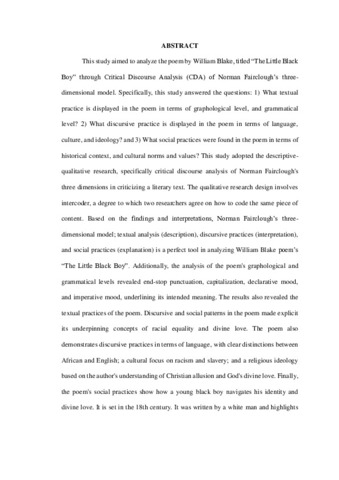Critical discourse analysis of William Blake’s “The Little Black Boy”
Abstract
This study aimed to analyze the poem by William Blake, titled “The Little Black Boy” through Critical Discourse Analysis (CDA) of Norman Fairclough’s three-dimensional model. Specifically, this study answered the questions: 1) What textual practice is displayed in the poem in terms of graphological level, and grammatical level? 2) What discursive practice is displayed in the poem in terms of language, culture, and ideology? and 3) What social practices were found in the poem in terms of historical context, and cultural norms and values? This study adopted the descriptive-qualitative research, specifically critical discourse analysis of Norman Fairclough's three dimensions in criticizing a literary text. The qualitative research design involves intercoder, a degree to which two researchers agree on how to code the same piece of content. Based on the findings and interpretations, Norman Fairclough’s three-dimensional model; textual analysis (description), discursive practices (interpretation), and social practices (explanation) is a perfect tool in analyzing William Blake poem’s “The Little Black Boy”. Additionally, the analysis of the poem's graphological and grammatical levels revealed end-stop punctuation, capitalization, declarative mood, and imperative mood, underlining its intended meaning. The results also revealed the textual practices of the poem. Discursive and social patterns in the poem made explicit its underpinning concepts of racial equality and divine love. The poem also demonstrates discursive practices in terms of language, with clear distinctions between African and English; a cultural focus on racism and slavery; and a religious ideology based on the author's understanding of Christian allusion and God's divine love. Finally, the poem's social practices show how a young black boy navigates his identity and divine love. It is set in the 18th century. It was written by a white man and highlights the boy's resiliency and his mother's teachings while stressing cultural values like honesty, courage, and racial equality.
Description
Abstract only
Subject
Recommended Citation
Amaraco, J.M.B., Diestro, J.B., & Baticados, L.B. (2023). Critical discourse analysis of William Blake’s “The Little Black Boy” [Undergraduate thesis, Capiz State University Pontevedra Campus]. CAPSU Institutional Repository.

